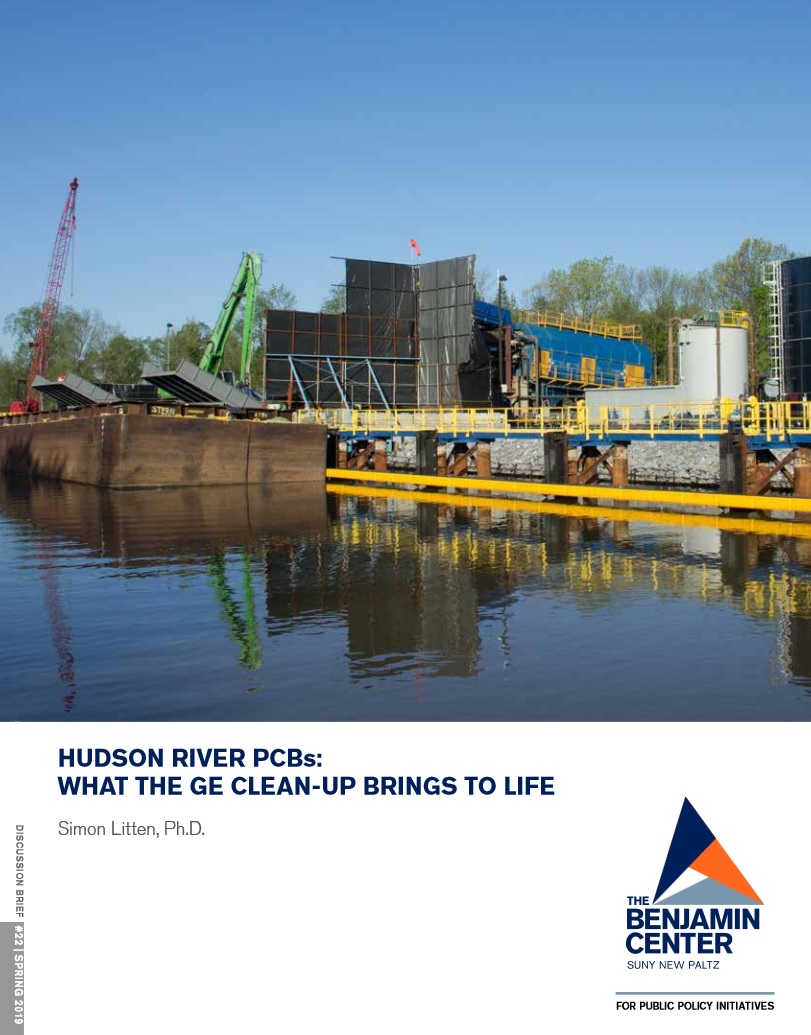Newest Benjamin Center brief: Lessons learned from history of Hudson River PCB pollution & clean-up
 The Benjamin Center for Public Policy Initiatives at SUNY New Paltz has published its 22nd discussion brief, “Hudson River PCBs: What the GE Clean-Up Brings to Life,” which tells the story of the pollution of the river and the subsequent fight for remediation.
The Benjamin Center for Public Policy Initiatives at SUNY New Paltz has published its 22nd discussion brief, “Hudson River PCBs: What the GE Clean-Up Brings to Life,” which tells the story of the pollution of the river and the subsequent fight for remediation.
Authored by Simon Litten of the New York State Department of Environmental Conservation (NYS DEC), Division of Water (retired), the new brief draws valuable policy lessons about the importance of preventing chemical pollution before crises develop.
Litten presents a history of the the rise and fall of PCB usage in industrial processes, beginning with their arrival to the marketplace in 1929. He considers this history through various social movements of the 20th century, including worker safety, environmentalism and a growing awareness of chemical toxicity.
The brief includes a graphic timeline of the Upper Hudson Remedial Superfund, from the state’s decision to close of the region to all fishing in 1976, to the federal Environmental Protection Agency’s April 11, 2019, certification that the General Electric Company’s mandated, $1.7 billion dredging and PCB removal effort was complete, pending further testing. New York State Governor Andrew Cuomo and Attorney General Letitia James have disputed the federal EPA’s decision to certify the project completed.
Litten’s narration of the history of PCBs in upstate New York, and the ongoing struggle to balance human health, ecological well-being, business needs and public expectations, serves as a classic case study of the social, economic and political challenges of dealing with toxic materials in our shared environment.
“When it comes to toxic pollution of our waters, this experience and others tell us that we need to worry far more about what we don’t know about chemicals and their effects—and find a way to do something about it before, not after, crises develop,” Litten writes. “The alternative is endless repetition of our region’s tortuous experience with GE’s cleanup of PCBs from the Hudson. This is a matter on which all should be able to agree: prevention would be far better and far cheaper than cleanup.”
Use this link to view and download “Hudson River PCBs: What the GE Clean-Up Brings to Life,” in its entirety.
About The Benjamin Center
The Benjamin Center (formerly CRREO) was established in 2007 to help SUNY New Paltz engage with communities, governments, not-for-profits and businesses across our region. The Benjamin Center conducts and publicizes research on important policies and topics; creates and directs select institutes focusing on specific areas of regional interest; connects and partners with local governments, not-for-profits and businesses to initiate reforms and advocate for best practices; contracts to assess the performance of public and not-for-profit agencies and programs; and works to foster intergovernmental collaboration and community engagement.
If you are interested in being on the mailing list for reports from The Benjamin Center, please send an email with your address to [email protected].
For more information on The Benjamin Center and its regional initiatives, visit www.newpaltz.edu/benjamincenter.

